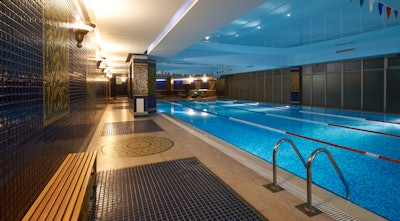
Back in 2010, I was involved in writing the first Model Aquatic Health Code, a federal effort led by the Centers for Disease Control and Prevention. As the only architect involved in the process, I sat on the Facility Design & Construction Committee, which focused on those components of the code. Our committee met regularly, sharing research on state codes and published standards, striving to find areas of consensus, creating our own language with scientific data when we could and noting areas where existing data was lacking.
Each committee member was responsible for spearheading the collaborative writing of specific sections of the code. One of my areas was pool decks, and it didn’t take long for me to realize that when it came to “slip resistance,” the aquatics industry lacked definitive data on what that term actually meant.
While almost all codes and standards required pool decks and locker/shower areas to be slip resistant, there was no industry standard for making them that way.
So I set out to find one.
Here’s the problem
I read more articles on slip resistance than I care to count, and although there were some well-established definitions and various testing methods for measuring slip resistance, few were relevant to a wet surface. As for those that were relevant, they were based on people wearing shoes — not patrons walking around barefoot.
In short, there was no way to concretely describe what a slip-resistant surface was, nor was there a way to test an in-place condition for slip resistance.
The “coefficient of friction” (COF) remains the most common specification term in design documents and product literature regarding slip resistance. Unfortunately, at the time, COF was inadequate, because it was a static test for a very dynamic problem.
The first MAHC was published in 2014, and it now undergoes biannual updates. The inaugural edition read like most health codes, regulating pool decks precisely in terms of widths, slopes and even materials, but vaguely as “slip resistant.” In fact, “slip resistant” was used throughout the code, but the term was never really given a true definition.
The MAHC Annex (sort of a companion “how to interpret” document) provided some guidance by referring to ADA Accessibility Guidelines or OSHA standards, as they are overseen by the only federal agencies that speak to the subject of slip resistance. But they, too, lacked specific guidance.
This is not an indictment of the original MAHC, but the reality of the flooring world at the time.
Now what?
In 2012, the International Building Code moved from a static coefficient of friction (SCOF) test to a new dynamic (DCOF) test, defined as ANSI A137.1–2012 and also known as the “AcuTest” using a device called the BOT-3000E.
This testing method was a vast improvement and can be used by both product manufacturers and professionals in the field. ANSI A137.1-2012 became the referenced standard by the Tile Council of North America in 2014 and the MAHC in 2016, so it should be in place in most jurisdictions by now.
Specifying and installing flooring with a minimum DCOF rating of 0.42 is the best way for designers and owners to document a Standard of Care. However, it is still based on wearing shoes, and ANSI disclaims a list of conditions that are entirely common to pool decks and shower areas.
So while the AcuTest is the best standard available, it does not guarantee against slips and falls. That is why there remains no substitute for good drainage and excellent maintenance of surfaces in all of a facility’s wet areas.
Next time, I’ll suggest solutions for how to best keep patrons safe on slippery surfaces in and around aquatics areas, as well as in locker rooms and showers.





































